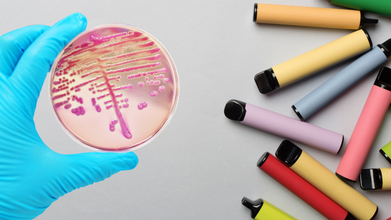- Health Conditions A-Z
- Health & Wellness
- Nutrition
- Fitness
- Health News
- Ayurveda
- Videos
- Medicine A-Z
- Parenting
Why 'Setting Boundaries' Should Be Your TOP New Year Resolution! 10 Ways To Protect Your Space

Setting Boundaries (Credit: Canva)
New year, new me! I said this to myself as the year 2025 started. But soon found myself hanging out with the same people I didn't agree with and drinking the same hot chocolate I hated. I realized that New Year's resolutions were not enough, I needed something more.
It was then I read the book How Neurobiology Can Help You Rewire Your Brain to Feel Safe, Connected, and Empowered by Juliane Taylor Shore, a therapist in Austin, Texas. I realised that stringent boundaries were pivotal to both personal and professional growth. Physical boundaries, for instance, protect your personal space while emotional boundaries protect your mental health.
But boundaries should not be confused with a request. For example, if you have a family member with a different political view, and you ask them to bring a certain candidate up that's a direct request. Whereas a boundary is saying, "I’m not comfortable with this conversation continuing. I'm no longer going to speak to you about this.’” Boundaries aren’t about controlling other people, she adds—they’re about taking action to protect your mental health. Terri Cole, a New York-based therapist and author of Boundary Boss emphasized that boundaries should be considered as "your own personal rules of engagement for how others will interact with you. If you don't set any boundaries, you are likely to become stressed and burned out. As resentment simmers, your relationships might become strained.
Here Are Few Tips You Can Use To Set Boundaries
Push Back Against Work Overload
For Shore, a working mom, the challenge isn’t her passion for work but the creeping demands that keep her from family time. She’s learned to pause before saying “yes” to new tasks, asking herself what she would have to sacrifice by taking on more. "The truth is, I can’t say yes to everything. If I do, I’ll have no time for what matters most,” she shared in her book. Shore’s deliberate approach helps her restore balance while setting an example for her young daughter. Her advice? Build in a buffer to consider your commitments, and don’t let people-pleasing derail your well-being.
Reserve Sacred Tech-Free Time
What would it feel like to start your day without diving into your devices? Going off tech for a few hours does wonders for your health. A new rule? No internet before 11 a.m. Instead, fill your mornings with activities that bring you joy, like walking your dog, meditating, or simply savoring coffee with your family.
Treat News Like A Snack
Health experts warn that doomscrolling has become a mental health drain in modern day. "Refreshing the headlines all day left me stressed and emotionally unavailable to my clients. His solution? Treating the news like it’s 1980—checking headlines just once or twice a day or opting for a weekly news digest. If you’ve felt the same pressure to stay constantly informed, a more measured approach could help you feel focused and optimistic.
Banish Tech From Bedroom
Are you tethered to your phone overnight? What if you start going to bed without your phone? Well, it might result in better sleep and a refreshed morning outlook. Emergencies are rare, as per health experts. You can let loved ones know in advance about your new habit. A good night’s sleep might just be the best gift you give yourself this year.
Expect Equal Effort in Relationships
Clinical psychologist Heather Stevenson used to carry conversations, filling in silences and drawing others out, often at the expense of sharing her own thoughts. It left her feeling drained and unfulfilled. Now, she is prioritizing balance in her relationships. "I want them to be mutual," she told a media organization. If you find yourself in one-sided dynamics, try stepping back and letting the other person share the load. True connections thrive on reciprocity.
Reconnect Face-to-Face
Virtual interactions have become a way of life, but for therapist Kathleen Smith, they began to feel stifling. She's now prioritizing in-person connections, declining unnecessary Zoom meetings and seeking out community events instead. "All those little side conversations when you’re face-to-face? They’re so good for mental health."
Stop Overapologizing
Do you apologize for things that aren’t your fault? Therapists want you to reconsider this habit as constant apologizing disempowers us. Instead, practice gratitude. Swap “Sorry for bothering you” with “Thank you for your time.” This subtle shift can transform how you’re perceived—and how you feel about yourself.
Say "Yes" With Intention
Mental Health experts emphasize the power of saying no. "Saying yes out of obligation goes against my values of connection and authenticity,” she explains. By tuning into your real desires, you can reserve your energy for what truly matters.
Protect Yourself from Energy Vampires
Do certain people leave you feeling drained? Therapist Sarah Rafik Botrus has learned to limit her exposure to these “energy vampires.” Whether it’s a quick phone call or a brief visit, she sets clear boundaries to preserve her mental health. Over time, these relationships often become less draining—or fade away entirely.
Reclaim Your Privacy
In an era of oversharing, many are scaling back their social media presence. “Not everything needs an audience. By savoring moments privately, people might feel more meaningful. If you’re ready to follow suit, start small: Try a social media detox for a week or limit your posts to a couple of days.
Hong Kong Fire: Essential Do’s and Don’ts You Must Follow During A Fire Emergency

Credits: AP
At least 55 people have lost their lives and 279 remain missing after Hong Kong’s most severe fire in more than a century swept through several high-rise towers on Wednesday afternoon, officials said. Fire crews are still trying to put out the blaze in the Tai Po area and reach those who are trapped inside. By early Thursday, authorities said they had managed to control the fire in four buildings, though teams were still working on three others more than 16 hours after the flames first appeared.
What Happened in Hong Kong?
A residential complex in the Tai Po district caught fire at around 2:51pm local time on Wednesday. The flames started on the bamboo scaffolding fixed to the outside of one of the buildings. This scaffolding, made of bamboo poles used by workers during repairs, burns very easily. Once it caught fire, the flames moved quickly up the outside of the building, spread into the apartments, and then reached nearby towers.
The blocks were also covered in green construction netting from the ground to the roof because renovation work was taking place. This netting caught fire as well and helped the flames advance at a faster pace. Local reports noted that the fire grew at incredible speed. By 3:34pm, it had reached a level four alarm, and by 6:22pm, it had been raised to a level five alarm, the highest alert in Hong Kong. It is now the deadliest fire the city has seen in more than 100 years.
Hong Kong Fire: How Did The Fire Start?
The blaze spread in minutes because it began on the bamboo scaffolding around the building and moved to the green netting covering the towers. Both materials burn very easily. Once they ignited, the flames climbed the outside of the tower and reached many floors above. Burning fragments then dropped to the ground and set nearby buildings on fire within minutes. Wind and the open gaps created during the renovation work likely pushed the flames even faster. While officials are still examining the exact cause, they said that the flammable scaffolding, the construction materials, and the tall buildings standing close together all played a part in letting the fire grow out of control, according to Al Jazeera.
Hong Kong Fire: Essential Safety Tips To Keep In Mind During A Fire Emergency
As per The American Red Cross society, here are some essential safety tips you should follow during incase a fire emergency strucks.
Smoke Alarms:
- Make sure your home is fitted with working smoke alarms.
- Place an alarm on every level of your home including inside each bedroom and outside every sleeping area. Connect the alarms so that they all sound together.
- Install alarms and alert tools to help family members who are deaf or hard of hearing.
- Alert tools such as strobe lights flash when the alarm rings. Pillow or bed shakers can help wake someone who is sleeping. These devices are triggered by the sound of the smoke alarm and shake the bed to warn the person about the fire.
- Test each alarm at least once a month. Press the test button to check that it works.
- Visit the Consumer Product Safety Commission website for details on smoke alarms that may have been recalled.
Home Escape Plan
- Create a home escape plan that includes two ways out of every room. Share this plan with all family members and guests.
- The plan should show two clear exits from each room and a meeting point outside the home.
- Make sure everyone in the house knows the plan.
- Practice your fire drill regularly.
- Ensure that children, older adults, and people with disabilities have the help they need during an escape.
- Keep stairways well lit to prevent falls.
- Clear clutter so no one trips while trying to leave quickly.
- Add handrails along both sides of staircases.
- If you live in an apartment, know where all exit staircases are located on your floor in case the nearest one is blocked by smoke or flames. Always use the stairs to leave the building. Do not use the elevator unless the fire department says you can.
Fire Response
- If there is a fire, get out quickly and stay outside. Then call 9-1-1.
- If you cannot leave the building, call 9-1-1 and tell the fire department you are unable to get out. Wave a light coloured cloth or a flashlight near the window to signal for help, but keep the window closed.
- If you see smoke, use your second escape route. If you must move through smoke, stay low and crawl under it.
After Criticism From Doctors, Sonali Bendre Explains Her View on Naturopathy For Cancer Treatment

Credits: Wikimedia Commons
Sonali Bendre, actor, who is known for talking about her cancer journey, inspiring other survivors to talk about it too, has found herself at the center of a heated debate after she spoke how naturopathy and autophagy helped her in her cancer recovery.
Bendre, who was diagnosed with stage 4 metastatic endometrial cancer in 2018, wrote on X that she believes autophagy played a role in her healing journey. Her post quickly drew sharp criticism from several doctors.
Doctors Point Out That Cancer Remission Came Through Medical Treatment
Members of the medical community reminded her that her remission was the result of evidence-based cancer treatments, including chemotherapy, radiation and surgery. Many emphasized that autophagy is not a recognized medical therapy and should not be presented as one.
One post from hepatologist Dr Cyriac Abby Philips on X said, “Your cancer went into remission after chemotherapy, radiation, and surgery at an advanced cancer treatment hospital. Not because of Naturopathy. Not because of autophagy. Because you have the option and privilege to opt for the best treatments from scientific practice to help you.”
Bendre Clarifies Her Stand
Following the criticism, Bendre clarified that she was sharing her personal experience as a survivor, not medical advice. She wrote that her journey included elements she explored with the help of her naturopath, and these practices were only part of her overall healing process. In her words, “I have never claimed to be a doctor, but I am certainly not a quack either. I am a cancer survivor, someone who has lived through the fear, pain, uncertainty, and rebuilding that the disease brings.”
What Autophagy Actually Is
Autophagy is a natural process in which the body breaks down and recycles old or damaged cell components. Cells contain various structures that help them function, and over time some of these structures wear out. Autophagy acts like a clean-up and recycling system. It allows cells to dismantle faulty parts and reuse the useful components to maintain healthy cell function. Anything that cannot be used is removed by the cell.
This process is an important quality control mechanism. If too much cellular waste builds up, it can interfere with normal cell activity. Autophagy helps keep cells efficient and healthy. The scientific understanding of autophagy grew significantly after Japanese biologist Yoshinori Ohsumi won the Nobel Prize in Medicine in 2016 for his work uncovering how it works. While autophagy is essential for survival, it is not considered a medical treatment for diseases.
Can Autophagy Treat Cancer?
Experts explain that autophagy plays a complicated role in cancer. In the early stages, it may help prevent tumor formation by clearing damaged components. However, in established cancers, the same process can allow tumor cells to survive stress and become more resistant to treatments like chemotherapy.
Disclaimer: Please consult a qualified doctor or oncologist before choosing any treatment for cancer. Health and Me does not endorse alternative therapies as substitutes for evidence-based medical care. This article is based on publicly available information. All medical conditions should be evaluated and managed under the guidance of a licensed healthcare professional.
E-Cigarettes Carry Fecal Bacteria Like E. Coli And More, More Details Inside

Credits: iStock and Canva
What if you are told that the vape you are using contains bacteria found in poop. You read that right. According to a study conducted by HAYPP along with Microbiologist Reynold Mpofu at BioLabTests, bacteria like staphylococcus and bacillus were found on vape, as well as fecal bacterium, E. coli is found on vape, which is often found in public bathroom.
What Did The Study Find?
More than 100 million people worldwide use e-cigarettes or vapes, and at least 1 in 6 people vape in toilet. Furthermore, vapes are rarely cleaned, and thus become germ hotspots.
The study found that vape mouthpieces are highly contaminated with bacteria. More than 1.5 million colony-forming unites or CFUs were identified on the vape mouthpiece, the maximum amount measurable by the lab, carrying as many as 2,300 times more bacteria than a public toilet, which has 50 CFUs per square inch.
“Laboratory analysis revealed that the mouthpiece is the dirtiest component of the vape. This isn’t surprising given that the human mouth, largely considered to be one of the ‘dirtiest’ parts of the body, harbors approximately 700 species of bacteria, that amounts to billions of individual bacteria,” said Mpofu.
The study was able to identify a range of bacteria, including skin microbes to gut bacteria like E.coli.
Also Read: UK Investigates Impact Of Vaping On Its Young Users
The Species Identified
The study identified these following bacteria on the vape:
- Bacillus: commonly found in dust and the air
- E.coli: indicates possible fecal contamination
- Yeast and mold: can cause respiratory irritation
- Staphylococcus: usually harmless, but could cause infection
- Enterococcus: intestinal bacteria that can persist on surfaces
The study was also able to identify bacteria on the vape body. The lab also observed a rapid microbial growth between just 2 to 3 days of use. These colonies could be seen multiplying thousand of times over.
While many of these are found on human skin or surrounding, some are intestinal bacteria, like aforementioned, E.coli, and Enterococcus, which points towards unwashed hands, explaining the transfer on the surface.
“Much like phones, vapes are frequently handled and placed on a variety of surfaces, allowing germs, oils, and dirt from hands, pockets and various environments to latch on the device. The findings confirmed the presence of bacteria, including E. coli and Enterococcus, on the vape body, likely arising from inadequate hand hygiene or the transfer of microorganisms from bathroom environments or other contaminated surfaces,” said Mpofu.
Read: Why Is My Idea Of Break Is To Have A Smoke?
The Timeline Of Bacteria Development
The first signs of microbes start to appear within the first day of buying a brand new vape, especially around the mouthpiece.
By day three, the vape accumulates more than 2,300 times the microbial load typically found on a toilet seat.
By the seventh day, bacteria like E.coli. and Enterococcus and other fecal indicators are detected on the mouthpiece and vape’s body. Mould and bacteria are also found on levels.
By day 14, despite no new use or cleaning, the vape remains heavily contamination. The contamination does not fade overtime.
© 2024 Bennett, Coleman & Company Limited

